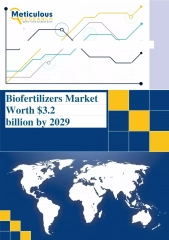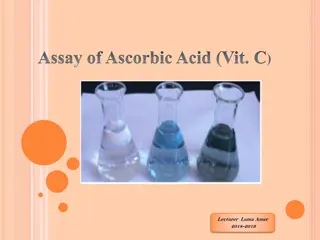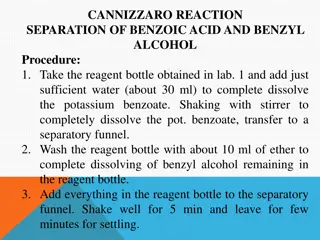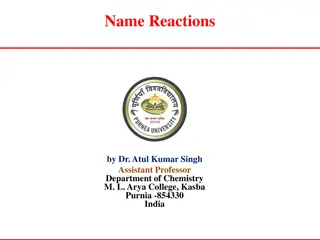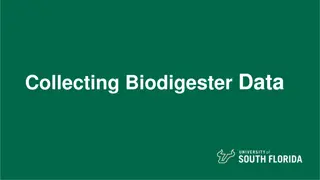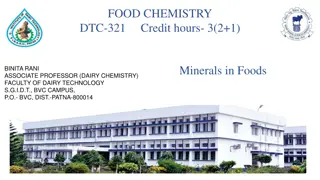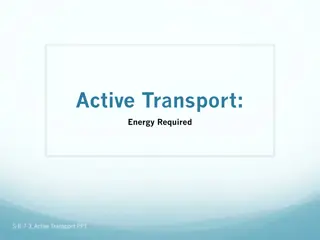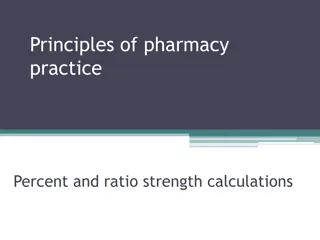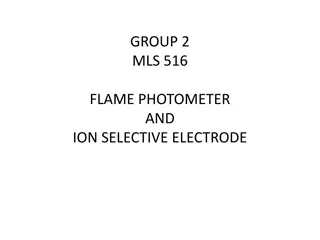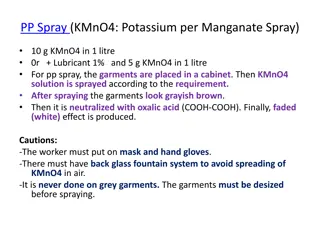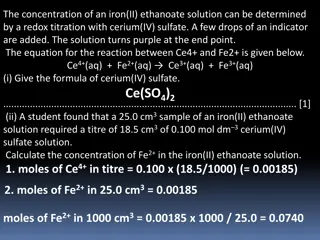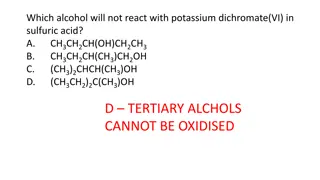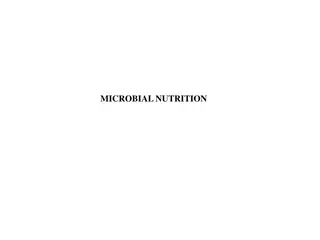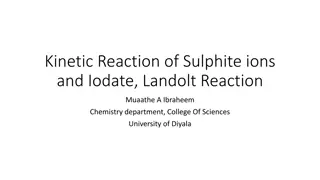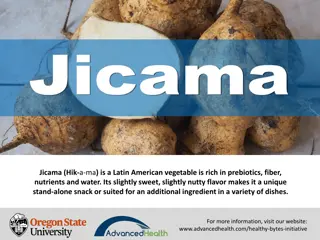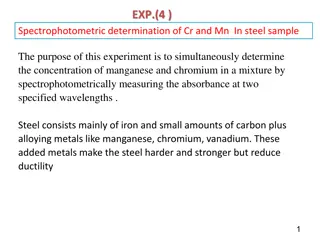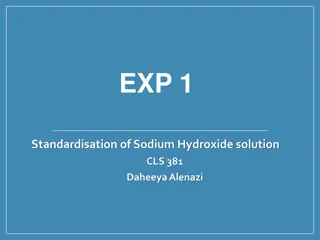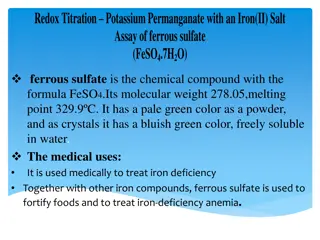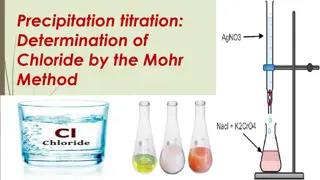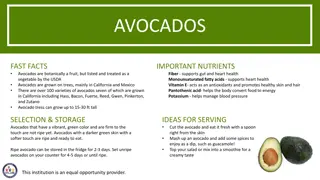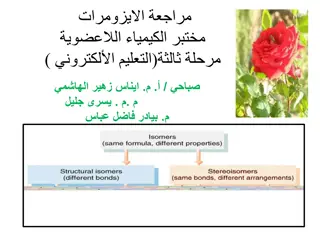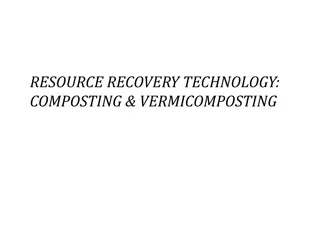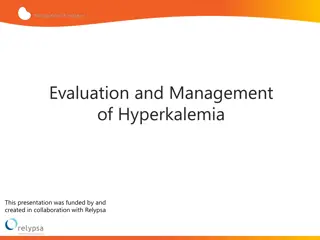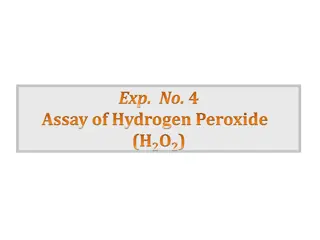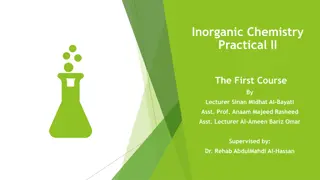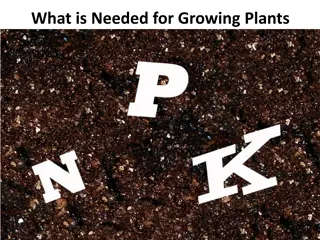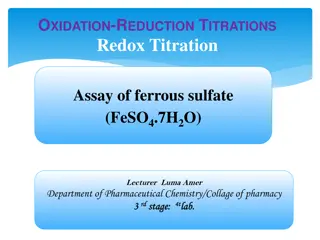Titration Colour Changes
This collection features various experiments in chemistry involving titration and solutions. It includes procedures such as standardizing hydrochloric acid using sodium carbonate, titrating hydrochloric acid with sodium hydroxide to produce sodium chloride, determining the concentration of ethanoic
0 views • 10 slides
ASPEN Staged Separation Unit-Ops
Introduction to Aspen Staged Separation Unit Operations for the purification of desired components by removing impurities and pollutants using distillation, absorption, and stripping columns. This technology is relevant to ammonia synthesis to prevent catalyst poisoning by removing CO2 through absor
0 views • 26 slides
Global biofertilizer market- Emerging trends and opportunities
The global biofertilizers market is segmented by microorganism type (nitrogen-fixing microbes, phosphate solubilizing & mobilizing microbes, potassium solubilizing & mobilizing microbes, other microorganism types), crop type (cereals & grains, oilseeds & pulses, fruits & vegetables, other crop types
1 views • 4 slides
Electrolyte and Metabolic Disturbances in the Critically Ill
Dr. Srilekha Ammapalli discusses the cations (sodium, potassium, calcium, magnesium) and anions (chloride, bicarbonate, phosphate, lactate) involved in electrolyte and metabolic disturbances in critically ill patients. The physiology, causes of abnormalities, diagnosis, evaluation, and management of
2 views • 104 slides
Assay of Ascorbic Acid (Vitamin C) - Method and Procedure
Ascorbic acid, known as Vitamin C, is a crucial organic compound with antioxidant properties. This article discusses the assay of ascorbic acid using a redox titration method with potassium iodate and iodide. The principle, procedure, and calculations involved in determining the concentration of Vit
1 views • 8 slides
Ready to Use 100% Natural Tomato Powder (500 gm Pouch)
Tomato Powder:\nTomatoes are the major dietary source of the antioxidant lycopene, which has been linked to many health benefits. They are also a great source of vitamin C. potassium, folate, and vitamin K. It is one of the most widely used ingredients in the Food and Beverage Industry having applic
1 views • 4 slides
Cannizzaro Reaction: Separation of Benzoic Acid and Benzyl Alcohol
The Cannizzaro reaction involves the separation of benzoic acid and benzyl alcohol by utilizing various reagents and procedures such as dissolving potassium benzoate, washing with ether, and treatment with different solutions to isolate the desired compounds. The process involves multiple steps incl
7 views • 4 slides
Understanding Hypokalemia and Potassium Regulation
Hypokalemia is a condition characterized by low potassium levels, crucial for intracellular functions. The Na+/K+ ATPase pump maintains the ICF/ECF gradient. Potassium excretion occurs mainly via the kidneys, with minimal variation in proximal tubule reabsorption. The collecting duct plays a vital r
2 views • 50 slides
Chemistry Regents August 2022: Questions and Answers
Explore the answers to questions from the August 2022 Chemistry Regents exam, covering topics like electron configuration, orbital definition in the wave-mechanical model, and electron energy shells in atoms. Understand concepts such as the number of protons in an atom, orbital definitions, and elec
0 views • 167 slides
Benzoin Condensation: A Name Reaction Explained by Dr. Atul Kumar Singh
Benzoin condensation is a classic organic reaction where aromatic aldehydes self-condense to form α-hydroxy ketones. Dr. Atul Kumar Singh, an Assistant Professor of Chemistry, details the mechanism and the specific catalytic properties of cyanide in this reaction. The reaction involves refluxing th
0 views • 6 slides
Introduction to Bioinorganic Chemistry and Essential Elements in Human Body
Bioinorganic Chemistry explores the role of inorganic elements in living systems, emphasizing the essential elements present in the human body. Understanding the significance of metals, such as calcium, potassium, and iron, highlights their crucial functions and the impact of deficiency or excess on
1 views • 21 slides
Biogas Production and Methane Content Measurement in Biodigester Research
Explore the process of collecting data in biodigester studies, focusing on biogas production, methane content, and related measurements. Learn how to read water levels, measure biogas, and assess methane content using sodium hydroxide or potassium hydroxide solutions. Practice techniques with fermen
0 views • 20 slides
Understanding the Importance of Minerals in Foods
Minerals play vital roles in food chemistry and human nutrition. There are main elements, trace elements, and ultra-trace elements present in foods that contribute to various physiological functions. Sodium, potassium, magnesium, and calcium are essential minerals with specific roles impacting human
6 views • 27 slides
Understanding Active Transport: Energy-Driven Cellular Processes
Active transport is a vital process in cells that require energy in the form of ATP to move materials across the plasma membrane against their concentration gradient. This process involves pumps, endocytosis, and exocytosis. The sodium-potassium pump in nerve cells is a classic example of active tra
0 views • 9 slides
Pharmacy Practice: Percentage and Ratio Strength Calculations
Understanding percentage and ratio strength calculations is crucial in pharmacy practice. Percentages can be expressed as fractions or decimals, and various concentrations like weight-in-volume and volume-in-volume are used in pharmaceutical preparations. Learn how to calculate the correct strength
0 views • 24 slides
Artificial Sweeteners: Types, Risks, and Benefits in Dairy Technology
Artificial sweeteners, including aspartame and acesulfame potassium, are widely used as sugar alternatives in various food products. While they offer sweetness without the calories, some artificial sweeteners have been linked to potential health risks. Understanding the different types of sweeteners
0 views • 13 slides
Understanding Flame Photometry and Its Applications
A photoelectric flame photometer is utilized in inorganic chemical analysis to determine metal ion concentrations such as sodium, potassium, lithium, barium, and calcium. The photometer measures light intensity emitted when elements are exposed to a flame. By controlling flame color intensity, the d
1 views • 25 slides
Garment Processing Techniques for Fading Effects
Learn about garment processing techniques such as PP Spray with Potassium Permanganate, P.P. Sponging, Tagging, and Destroy for creating unique fading effects on denim, twill, poplin, and corduroy garments. Follow safety precautions and specific procedures outlined for each technique.
0 views • 8 slides
Chemical Analysis and Redox Reactions in Chemistry
Iron(II) ethanoate concentration determination using redox titration with cerium(IV) sulfate, balanced redox equations for manganate(VII) ion oxidizing iron(II) ion, and calculations of iron percentage in samples using titration with potassium manganate(VII). Molarities and concentrations are calcul
1 views • 6 slides
Organic Chemistry Reactions Overview
This content covers various aspects of organic chemistry reactions, including the oxidation of alcohols with potassium dichromate, the solubility of molecules in water, and the oxidation of propan-1-ol to form aldehydes or carboxylic acids. It also explores the oxidation of butan-2-ol and the suitab
0 views • 9 slides
Understanding Microbial Nutrition and Growth Factors
Microbes require carbon for metabolic activities, with organisms categorized as heterotrophs or autotrophs based on their carbon source. In addition to carbon, macronutrients like nitrogen, phosphorous, sulfur, potassium, and magnesium are crucial for cell function. Growth factors such as amino acid
0 views • 15 slides
Kinetic Reaction of Sulphite and Iodate - Landolt Reaction Overview
The kinetic reaction of sulphite ions and iodate in the Landolt reaction is a fascinating chemical process where slow and fast reactions occur sequentially, resulting in a visually striking color change. By monitoring the induction period between the two reactions, one can observe the formation of h
0 views • 9 slides
Discover the Health Benefits of Jicama: A Nutrient-Rich Latin American Vegetable
Jicama, a Latin American vegetable, is rich in prebiotics, fiber, nutrients, and water. With its slightly sweet, nutty flavor, it's a versatile ingredient perfect for snacks or enhancing various dishes. Packed with essential vitamins like C and B6, minerals like potassium and iron, and prebiotic fib
0 views • 11 slides
Spectrophotometric Determination of Cr and Mn in Steel Samples
This experiment aims to determine the concentrations of manganese and chromium in steel samples by converting Cr3+ and Mn2+ ions to light-absorbing forms, followed by spectrophotometric measurements at specific wavelengths. Steel samples are oxidized, dissolved, and further oxidized to form dichroma
0 views • 10 slides
Standardisation of Sodium Hydroxide Solution Experiment
The experiment focuses on the standardisation of sodium hydroxide solution using potassium hydrogen phthalate by titration method. It discusses the types of standard solutions, criteria of primary standards, and the difference between standardisation and titration methods. The objective is to determ
1 views • 26 slides
Redox Titration: Potassium Permanganate with Iron(II) Salt Assay
Ferrous sulfate (FeSO4.7H2O) is used in medical treatments for iron deficiency. This article discusses the redox titration process involving potassium permanganate and ferrous sulfate, along with the chemical principles, procedure, and calculations involved. Potassium permanganate is a powerful oxid
5 views • 7 slides
Determination of Chloride by Mohr Method
Precipitation titration is a volumetric method used for determining chloride ions. Mohr's method involves reacting alkaline or alkaline earth chlorides with silver nitrate in the presence of a potassium chromate indicator. The endpoint of the titration is signaled by the appearance of red silver chr
0 views • 9 slides
Understanding Major Intra and Extracellular Electrolytes in Body Fluids
Body fluids contain various electrolytes crucial for maintaining cell and tissue environments. Electrolyte balance is essential for overall health, and external electrolyte replacement therapy may be necessary in certain conditions. The body's fluid compartments - intracellular, interstitial, and pl
0 views • 10 slides
All About Avocados: Facts, Nutrients, Selection Tips, and Activities
Avocados, although botanically fruits, are considered vegetables by the USDA. They are grown in California and Mexico, with over 100 varieties available. Rich in nutrients like fiber, monounsaturated fatty acids, and potassium, avocados offer various health benefits. Learn how to select and store av
0 views • 5 slides
Understanding Geometrical Isomers in Potassium Chromate Complexes
Explore the preparation methods, crystal shapes, and properties of cis and trans isomers of potassium chromate complexes. Learn about the use of oxalic acid and potassium dichromate, compare the two isomers, and understand the oxidation and reduction reactions involved.
3 views • 8 slides
Understanding Composting and Vermicomposting Technology
Composting and vermicomposting are controlled decomposition processes of organic materials, with aerobic microbes breaking down the matter in the presence of oxygen. Aerobic composting produces stable humus and helps eliminate pathogens and weed seeds. The processes involve microbial respiration, ga
1 views • 29 slides
Visual Element Test Review for Chemistry Enthusiasts
Explore a visually engaging collection showcasing various chemical elements with detailed descriptions. Discover images of Titanium, Carbon, Zinc, Potassium, and more, providing an informative overview of key elements in chemistry.
0 views • 51 slides
Evaluation of Resistant Hypertension and Hypokalemia in a Young Female
A 38-year-old female with a history of resistant hypertension and hypokalemia was referred for evaluation. She had been on multiple antihypertensive medications but still had uncontrolled blood pressure and low potassium levels. After treatment with potassium supplementation and adjustment of medica
0 views • 50 slides
Understanding Hyperkalemia: Causes, Evaluation, and Management
Hyperkalemia is a condition characterized by elevated serum potassium levels, posing serious risks such as cardiac arrhythmias and sudden death. Pathogenesis involves factors like abnormal potassium release, impaired distribution, and excretory process impairment. Causes range from pseudohyperkalemi
0 views • 35 slides
Assay of Hydrogen Peroxide (H2O2) - Experimental Study
Hydrogen peroxide (H2O2) is a weak acid with both oxidant and reductant properties. It is an unstable compound that decomposes into oxygen and water. This experiment involves titrating hydrogen peroxide against a standard oxidizing agent solution to determine its concentration. The physical and chem
0 views • 9 slides
Inorganic Chemistry Practical II: Preparation and Properties of Potassium Alum
This practical guide covers the preparation and properties of potassium alum, a versatile chemical compound used in various industries. Learn about its crystal structure, uses, and methods of preparation through detailed experiments and analysis.
0 views • 8 slides
Exploring Color Combinations with Chemical Reactions
Explore various color combinations using aqueous solutions of potassium dichromate, copper sulfate, and other colorless solutions. By mixing these solutions, generate distinct colors in test tubes through chemical reactions. Different hues such as yellow, blue, orange, light purple, and green are ac
0 views • 6 slides
The Essentials of Plant Nutrition: Nitrogen, Phosphorus, and Potassium
Plants require a balanced diet of nutrients for growth and development. Nitrogen stimulates above-ground growth, phosphorus enhances root growth and flower formation, while potassium promotes fruit development. However, excessive use of fertilizers can lead to environmental issues like algal blooms,
0 views • 6 slides
Global Potassium Phosphate Market Outlook and Key Players
The global potassium phosphate market is projected to reach USD 399.6 million by 2027, driven by a surge in demand for potassium phosphate in food processing and kidney-related applications. Key players in this market include BASF SE, Evonik Industries AG, Baker Hughes Incorporated, and others. Dist
0 views • 4 slides
Assay of Ferrous Sulfate (FeSO4.7H2O) by Redox Titration Experiment
This experiment involves determining the weight and weight percentage of an unknown sample of FeSO4.7H2O through a redox titration using potassium permanganate solution. Ferrous sulfate, a chemical compound used in medical treatments, is oxidized to ferric sulfate in the presence of sulfuric acid. T
0 views • 9 slides


